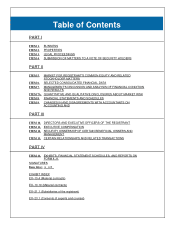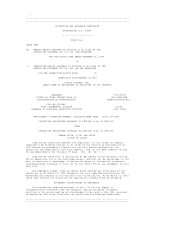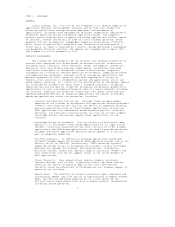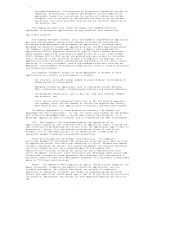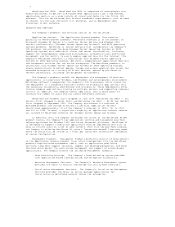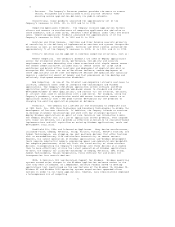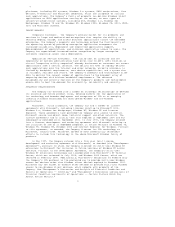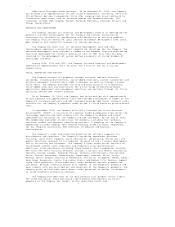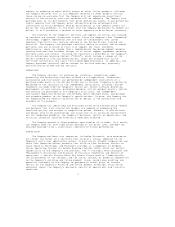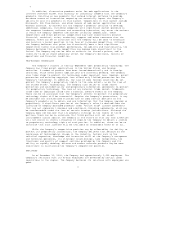Citrix 2000 Annual Report Download - page 7
Download and view the complete annual report
Please find page 7 of the 2000 Citrix annual report below. You can navigate through the pages in the report by either clicking on the pages listed below, or by using the keyword search tool below to find specific information within the annual report. 5
− Extranet. The Company's Extranet product provides the means to create
secure, encrypted and authenticated virtual private networks (VPN)
ensuring secure application delivery via public networks.
Collectively, these products accounted for approximately 12% of the
Company's revenues in 2000, 10% in 1999 and 5% in 1998.
Computing Appliances Products. The Company licenses Application Servers
clients and servers to manufacturers of computing appliances who add value to
these products, and in some cases, remarket these products under their own brand
names. Computing Appliances Products accounted for approximately 1% of the
Company's revenues in 2000, 2% in 1999 and 9% in 1998.
Services and Other Revenue. Services and Other Revenue consists primarily
of consulting in the delivery of implementation services and systems integration
solutions as well as customer support. Services and other revenue accounted for
approximately 7% of the Company's revenues in 2000, 4% in 1999, and 4% in 1998.
Citrix's solution can be applied in numerous computing situations, such as:
Remote Computing. The Company's products are used to deploy applications
across the enterprise whose scale, performance, reliability and security
requirements are more demanding than those associated with simple remote access.
The remote computing market includes dial−in remote access for large field
workforces and branch office locations and deployment of applications over an
enterprise WAN. Without the use of MetaFrame software, remote deployment of
these applications can be slow and expensive because LAN applications typically
require a substantial amount of memory and fast processors on the desktop and
relatively high−speed communication bandwidth.
Web Computing. As use of the Internet and corporate intranets continues to
increase, companies often need to integrate web technologies and Windows
applications. The Company's MetaFrame application server software and NFuse
application portal product provide web−based access to standard and custom
developed Windows or UNIX applications, and content via the Internet, extranet,
or intranet when used in conjunction with a web server. For example, using the
Company's products, an organization could add secure interactive access to an
application directly from a web page without developing any new programs or
changing the existing application program or database.
Terminals. The Company has licensed its ICA technology to companies such
as IBM, Acer, Sun, QNX, Wyse Technology and Boundless Technologies to enable the
development of low−cost terminals. In addition, the Company intends to continue
to develop strategic relationships and work with key strategic partners to
deploy Windows applications on point of sale terminals and information kiosks.
The Company believes that its line of application server products, when coupled
with these new devices, will provide an effective alternative to character−based
implementations and will capitalize on existing Windows applications, tools and
development facilities.
Hand−held PCs, PDAs and Information Appliances. Many device manufacturers,
including Psion, Compaq, Motorola, Sharp, Fujitsu, Hitachi, Hewlett Packard, and
Symbol Technologies, are shipping low cost portable devices that offer features
such as extended battery life and wireless connectivity to remote servers.
However, the latest generation of Windows applications and Windows development
tools require substantial memory, processing power and communications bandwidth
for adequate performance, which may limit the functionality of these wireless
devices. Incorporating the Company's technology into these devices will enable
them to more effectively utilize the latest generation of Windows applications.
To date, the Company has licensed technology to Compaq, Motorola, IBM, Sharp,
Symbol Technologies, Telxon Corporation, Psion Software PLC and others for
incorporation into certain devices.
UNIX, X−Terminal, DOS and Macintosh Support for Windows. Windows operating
systems caused major changes in the Windows application software market at the
time they were introduced. As independent software vendors moved to develop
applications that capitalized on the new features of the Windows 95, Windows 98,
Windows NT and Windows 2000 operating systems organizations upgraded client
systems in order to run these applications. However, many organizations employed
a heterogeneous mix of computing
5


